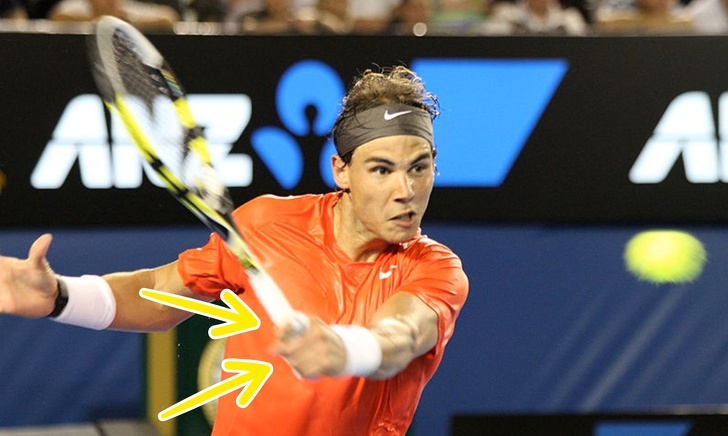85 percent of the population is right-handed, 10 percent is left-handed and 5 percent is ambiguous. These numbers refer only to lateral hand, but the predominance of one part of the body over another is reflected not only in the hands, but also in the legs, hips or eyes, between others. Being right-handed or left-handed makes a difference in various fields, such as sports.

Laterality can be defined as a systematic preference for the use of a particular organ of the body (eyes, ears, arms, legs …) in daily activities. There has been a lot of discussion about the benefits of preferred use on one side or the other, and the truth is that in many cases there is no clear scientific evidence on the right or left.
In addition, laterality affects each sport differently, and sometimes it really matters not whether, for example, the left or right hand is used, but if the dominant eye or director is on the same or opposite side.
Is laterality congenital or acquired?
Among the most controversial issues is if laterality responds to hereditary factors or, conversely, is due to environmental or cultural factors. The first option, genetic definition, is even supported by studies of the influence of specific genes.
Those who advocate the second possibility argue that the environment is right-handed, and most cultures encourage the use of the right hand. This is why lefties are more or less adapting to this general trend.
In the field of sports, this hypothesis has been supported by research that has shown that when training with an unattractive penis is increased, you can reduce the difference in performance from the dominant penis and even eliminate it.
Based on these results, working on the other side of the body during injury or illness can have a decisive effect on the injured side.
But this ability to change laterality is not for everyone. José Naranjo Orellana, professor of physical activity physiology at the Pablo de Olavide University in Seville, notes that “in some cases, the non-dominant limb (arm or leg) can be trained, but the right or left side of the director’s eye cannot be changed”
Lefty Benefits
Can a right-hander or a left-hander be decisive in a competition? There are several examples that show the distinct advantages of being left-handed in certain one-on-one sports. In fact, for this reason, some left-handers are credited with memorable victories.

Surprisingly, this could explain, at least in part, this phenomenon, as most boxers will be more used to fighting right-handed than left-handed. But there are also those who also refer to the angle that the left-hander gets into, which will prevent the opponent from defending properly.
Intersected laterality
Naranjo emphasizes that in terms of athletic performance in many sports, the type of laterality is more important than left or right-handed. Thus, in the case of tennis or paddle, lateral laterality appears to offer a significant advantage.
They talk about uniform laterality, when there is an absolute predominance of one of the sides of the body and the cross, when there is no uniform dominance of the same side. For example, when the directing eye is on the left, but the dominant foot is on the right.
Lefties make up 10 percent of the population, but over the past three decades, the number 1 in the ATP rankings has been left-handed 33 percent of the time. is 38 percent in women.
Biomechanics expert Paul Dorochenko, who was the physical trainer of Roger Federer, noticed that almost all tennis players who took the top ten ATF presented cross laterality between the eye and the hand. “Rafa Nadal crossed paths,” says Naranjo. “He’s left-handed, but he plays with his right hand to cross him with a guiding eye.”
Likewise, in football, they speak of “players who play on the lane, who are on the right, but play on the left flank”, which increases the danger to their opponents.
How to determine laterality
Dorochenko described some simple steps that can help determine the transverse nature of various body parts.
Main Eye
Hold an elongated sheet of paper with a 0.5 centimeter hole in the center with your hands. Focuses with two eyes open and through a hole on an object two or three meters away. Close one eye at a time and the other without moving the position of the blade. The guiding eye is the one with which you see the centered object inside the hole when the other is closed.
Dominant shoulder
Stand facing the wall with your arms outstretched and leaning against it. Ask someone to throw an object at you from behind (such as a ball) and ask you to turn and catch it. If you turn to the left, the dominant shoulder will be on the right, and vice versa.
Dominant hand
This is the one with whom we write, eat and complete our daily tasks.
Dominant thigh
Stand straight with your legs apart and your hands on your waist. Pivot jump to try to make a 360º pivot, first one way and then the other. If the turn is fuller and more balanced on the left side, your dominant hip is on the right.
Dynamic stage
This is the leg that we raise when we jump with the scissors. This is also the edge we go spontaneously with if we want to crush something
Director’s Leg
This is the foot with which you hit the ball to shoot with greater precision.
